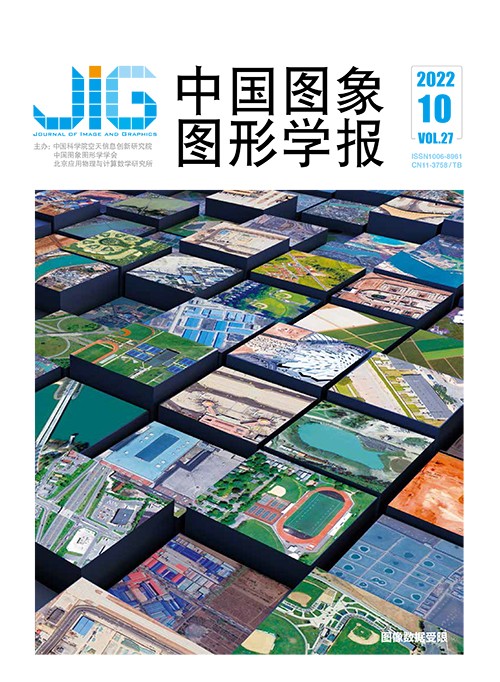
自适应权重金字塔和分支强相关的SAR图像舰船检测
摘 要
目的 合成孔径雷达(synthetic aperture radar,SAR)图像舰船目标检测在军事、民生领域发挥重要作用。由于SAR图像背景复杂且多为小尺度舰船目标,同时图像中的相干斑噪声导致舰船目标边缘模糊,现阶段目标检测模型无法快速高效地实现目标检测任务。为了提高模型检测精度,使模型具有更好的鲁棒性,提出了自适应权重金字塔和分支强相关的SAR图像检测模型。方法 对特征提取网络提取的特征图经过采样、融合处理获得特征自适应权重,然后利用权重指导每层特征图充分融合空间位置信息和语义信息,更好地检测小尺度目标;分支强相关模块融合分类分支和回归分支的特征,对融合后的待检测特征分别采用1×1、3×3对称卷积核和1×3、3×1非对称卷积核捕获不同的舰船特征;构建IoU (intersection over union)分支,利用IoU分支作用于分类分支,避免高IoU低分类置信度的候选框被抑制,通过设置平衡因子平衡IoU分支和分类分支,使其能更好地指导回归分支优化候选框。结果 在公开的遥感数据集SSDD (SAR ship detection dataset)上实验结果表明,本文模型的检测精度达到90.53%,F1值提升至94.35%,检测速度达到20.14帧/s。与其他SAR图像舰船目标检测算法相比有较好的检测效果。结论 实验结果表明该模型相比原始模型具有更好的检测效果,满足实时性检测需求,在SAR图像实时检测中具有实际意义。
关键词
Ship detection in SAR images based on adaptive weight pyramid and branch strong correlation
Guo Wei, Shen Lei, Qu Haicheng, Wang Yaxuan, Lin Chang(College of Software, Liaoning Technical University, Huludao 125105, China) Abstract
Objective Synthetic aperture radar(SAR) imaging is interfered with the echo due to electromagnetic waves penetrate the rough object surface by emitting electromagnetic pulses and receiving reflected echo imaging, resulting in coherent spot noise. However, its multi-temporal and all-weather features are used in maritime applications like rescue, monitoring and vessel transportation supervision. Constant false alarm rate algorithm is use for SAR image target detection in common. It has the simple algorithm structure, but the complex and uneven distribution of ocean clutter types can cause missing detection. In the case of multiple targets, it is easy to appear that the reference unit contains target information, so the amplitude of target signal may be greater than the clutter amplitude, resulting in the estimated threshold is far greater than the real threshold. The constant false alarm rate algorithm cannot obtain the ideal detection effect. In recent years, with the rapid development of deep learning, object detection algorithms based on deep learning have achieved good results in optical image object detection. SAR images are different from optical images in that the targets in SAR images are mostly small-scale ships with bright spots and lack obvious details. Similar targets such as islands, buildings and so on will form similar ship shapes after electromagnetic wave reflection. Therefore, the application of optical detection models directly to SAR images cannot achieve ideal results. Feature pyramid network adopts top-down layer by layer fusion, so the high-level feature map lacks spatial location information, and the fusion of each level largely loses the semantic information contained in high-level features, while the semantic information of low-level features is insufficient. In order to improve the model detection accuracy and make the model more robust, a SAR image detection model with adaptive weight pyramid and branch strong correlation is proposed in this paper. Method The high-level features extracted by ResNet101 contain rich semantic information, and the underlying features contain rich spatial information. To have a better detection effect of target detection model, the feature map is required to contain semantic information and spatial location information both. Therefore, the featured information needs to be adopted based on a more effective fusion mechanism for fusion. It is necessary to use effective weights to guide the fusion mechanism for to the integration of more effective information. Our adaptive weight pyramid module is demonstrated, which first samples the feature map to make it have the same scale, then stitches concatenation the feature map after each layer of sampling into channel dimensions, adjusts the number of channels by 1×1 convolution, and generates the weight in the end through the Softmax function. To get a feature map of the layer, multiply each layer feature by the corresponding weight, and the other layers are analogy. Its fusion removes some redundant information under the weighting of machine learning. Multiple features are extracted through 1×1 and 3×3 symmetric convolution kernels and 1×3 and 3×1 asymmetric convolution kernels, following the feature fusion of classification branch and regression branch by the branch correlation module. The feature diagram contains the classification branch information in the regression branch based on the fused classification and regression features. In the detection phase, the candidate boxes are removed related to accurate positioning and low classification confidence, which reduces the detection accuracy of the model greatly. In order to solve this problem, the intersection over union(IoU) detection head is constructed in the regression branch, and IoU it is used for classification branch, thus avoiding the problem of the candidate box with high IoU low classification confidence being suppressed. In order to balance the IoU branch and the classification branch, the constrained balance factor is designed sand can guide the regression branch optimization candidate box better. Result Our model is evaluated on the public remote sensing dataset SSDD(SAR ship detection), which had 1 160 pictures, including 2 456 vessel targets. The dataset is divided dataset into training sets and test sets by a ratio of 7:3, and enhanced the learning ability of the model by rotating, flipping, brightness and increasing Gaussian noise. All the experimental environments are based on ubuntu16.04 LTS operating system, equipped with CPU for lntel (R) Core (TM) i7-7700@3.6 GHz×8, graphics card for NVIDIA GTX1080Ti memory for 11 GB, running under the Tensorflow framework, through CUDA8.0 and cuDNN5.0 accelerated training. Our model learning rate is set to 0.000 5, the learning rate is attenuated by 1/10 per 40 k iterations, and the network is convergent at 80 k iterations completely. The non-maximum suppression threshold is 0.5 and the predicted probability threshold is 0.6. The recall rate, accuracy rate, average accuracy, F1 value and detection speed are represented as the evaluation indexes of the model. The model realizes the best detection effect in terms of equilibrium factor takes 0.4. The final recall rate is increased from 89.17% to 93.63%, the accuracy rate is increased from 87.94% to 95.08%, the average accuracy is increased from 86.91% to 90.53%, F1 value is increased from 88.55% to 94.53%, and the detection speed reached 20.14 frame/s. Conclusion Our experimental results demonstrate that the feature map targets fused by adaptive weight pyramids are more prominent, and the strong correlated branches module enhances the correlation between the classification branch and the regression branch, and improves the candidate box regression ability. Our model has it potential to meet the real-time detection requirement of SAR imaging.
Keywords
|



 中国图象图形学报 │ 京ICP备05080539号-4 │ 本系统由
中国图象图形学报 │ 京ICP备05080539号-4 │ 本系统由